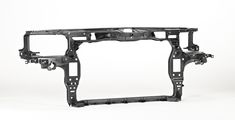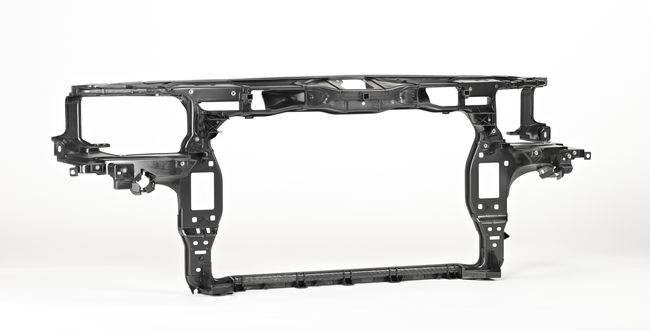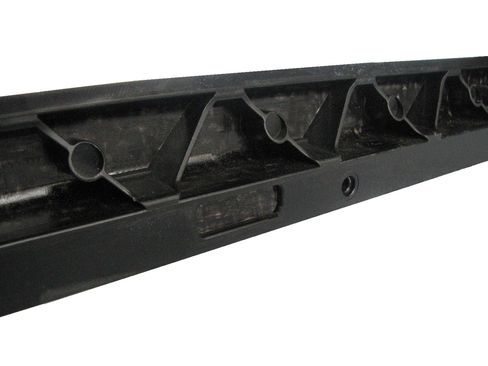Asia
EMEA

LANXESS Canada Contacts
Contact our Sites in Canada
Media Inquiries
General Inquiries
Please click here to e-mail LANXESS Canada with product inquiries and general requests.
Global Press Releases
2010-03-17
Premiere in the automotive industry:
Front end produced by hybrid technology with organic plastic sheet
The plastic-metal composite technology invented by LANXESS, also known as hybrid technology, has become firmly established in the automotive industry for the manufacture of lightweight, high-strength structural parts such as front ends, pedal support brackets and brake pedals. Previously, steel or aluminum sheet was used as the metal component. Now, for the first time, an organic plastic sheet has been used alongside aluminum sheet in a hybrid front end: for the lower beam of the front end of the new Audi A8, where a U-shaped profile made of the lightweight material is used. "This front end proves that organic sheet meets all the requirements relating for instance to torsional and flexural strength. It is an excellent alternative to steel and aluminum sheet in hybrid technology. We regard the component as an intermediate step to all-plastic hybrid front ends that are manufactured on the production line using only inserts of organic sheet in combination with polyamide 6," said Ulrich Dajek, a design expert at LANXESS.
LANXESS, the specialty chemicals group based in Leverkusen, Germany, supplies tailor-made polyamide 6 grades from its Durethan range not only for producing the organic sheet but also for injection molding the hybrid front end. The organic sheet is produced by Bond-Laminates GmbH in Brilon.
Organic sheets are thermoplastics (in this case with polyamide 6 as the matrix) reinforced with continuous fibers. Because of their high strength and stiffness combined with low density, they make outstanding lightweight construction materials. To manufacture a hybrid component, the organic sheet is first heated, formed and trimmed. The part is then placed in an injection molding tool and strengthened with ribbing or reinforcements made, for example, of polyamide 6, thus forming a material bond. Together with a number of its partners, LANXESS is currently working on transferring the previously separate forming step into the injection mold, so that the forming and injection processes can be carried out in a single operation for greater cost-effectiveness and productivity.
Weight-saving potential
The organic sheet reinforcement for the lower beam – aluminum sheet is used for the upper beam – is just 1.0 mm thick. When the car is out on the road, the part is subjected to considerable loads because the lower beam carries, among other things, the lower leg protection, the bumper, the underbody protection and the fixing point for the cooling module. Despite this, it was possible to design the U-shaped profile thinner than with aluminum sheet. "We estimate that the use of organic sheet instead of aluminum sheet can, in general, open up further weight-saving potential of around 10 percent," said Dajek.
Easy-flow polyamide 6 saves costs
Easy-flow Durethan BKV 30 EF polyamide 6 reinforced with 30 percent glass fibers is used to injection mold the hybrid front end. It can be processed with injection pressures that are up to 40 percent lower than with comparable standard grades of polyamide 6. This means less mold wear and therefore lower mold maintenance costs. Apart from that, walls can be made thinner, and finely structured geometries can be reproduced more accurately. Additional savings come from lower injection temperatures (energy consumption, cycle time). Furthermore, fewer gating points are needed, which helps to achieve uniform orientation of the glass fibers and thus minimize shrinkage and warpage.
High level of functional integration
As with earlier hybrid front ends, many functions are integrated into the hybrid front end of the Audi A8, which considerably simplifies subsequent assembly and the logistical operations connected with it. Such functions include fixing points for the radiator, the crash sensor, the air scoop for the oil cooler and the headlamp and its bezel. Also integrated are threaded bushings and the connections to the fender carrier and the bumper skin.
Tailor-made service for development and production
LANXESS provided its partners with comprehensive support in developing the front end. For example, mold flow analyses were carried out to minimize component warpage and achieve optimum filling of the mold. Furthermore, the torsional and flexural behavior of the organic sheet carrier were tested to validate the simulation of its crash behavior. When simulating the design of the part, it was a big advantage that LANXESS already had the mechanical data for both the organic sheet and the easy-flow polyamide 6 that is used as the other component in the injection molding process. Finally, the company's experts were also able to give assistance with mold proving and production start-up.
Forward-Looking Statements
This news release contains forward-looking statements based on current assumptions and forecasts made by LANXESS AG management. Various known and unknown risks, uncertainties and other factors could lead to material differences between the actual future results, financial situation, development or performance of the company and the estimates given here. The company assumes no liability whatsoever to update these forward-looking statements or to conform them to future events or developments.
Information for editors:
All LANXESS news releases and their accompanying photos can be found at http://corporate.lanxess.de/en/media/press-releases/. Recent photos of the Board of Management and other LANXESS image material are available at http://fotos.lanxess.de/index_en.html. The latest TV footage, audiofiles and podcasts can be found at http://corporate.lanxess.com/en/media/audio-video/.
You can find further information concerning LANXESS chemistry in our WebMagazine at http://webmagazine.lanxess.com.
LANXESS is a leading specialty chemicals company with sales of EUR 5.06 billion in 2009 and currently around 14,300 employees in 23 countries. The company is represented at 43 production sites worldwide. The core business of LANXESS is the development, manufacturing and marketing of plastics, rubber, intermediates and specialty chemicals.
- Gallery






